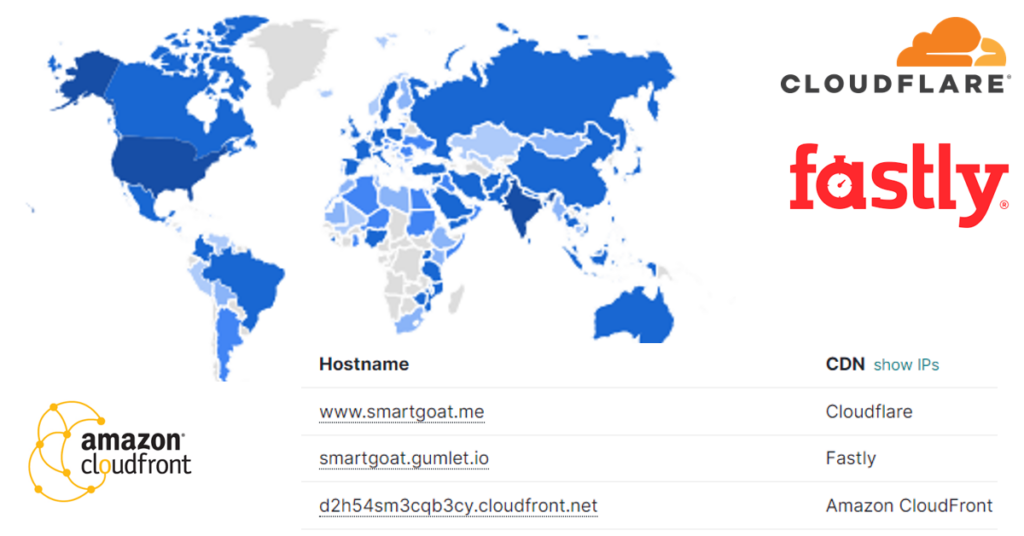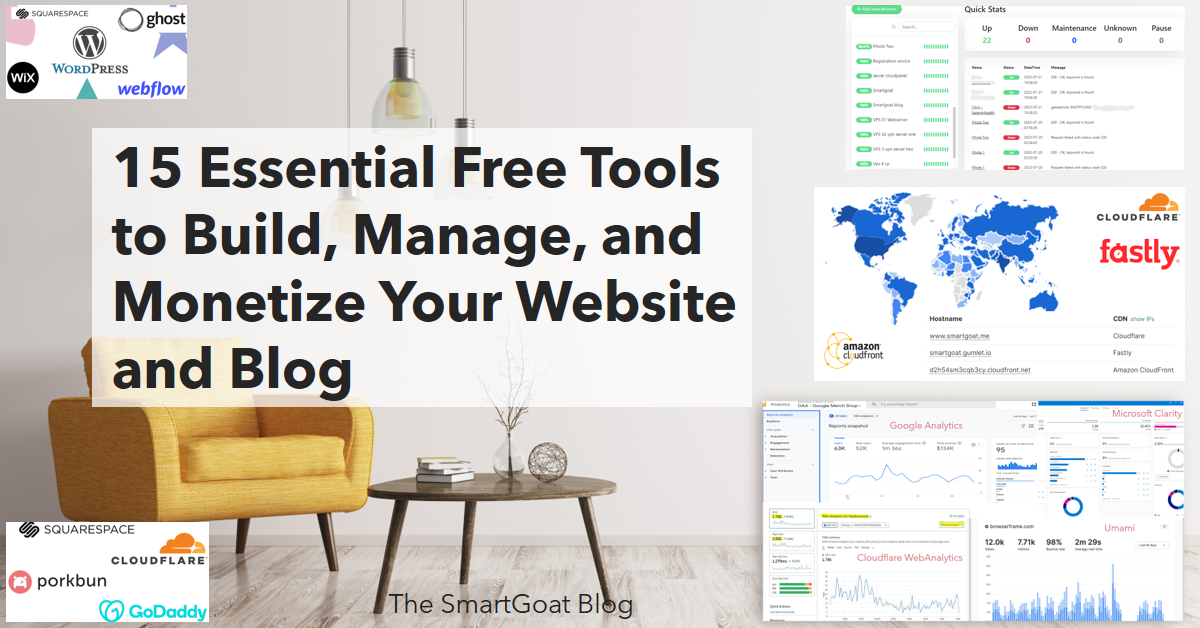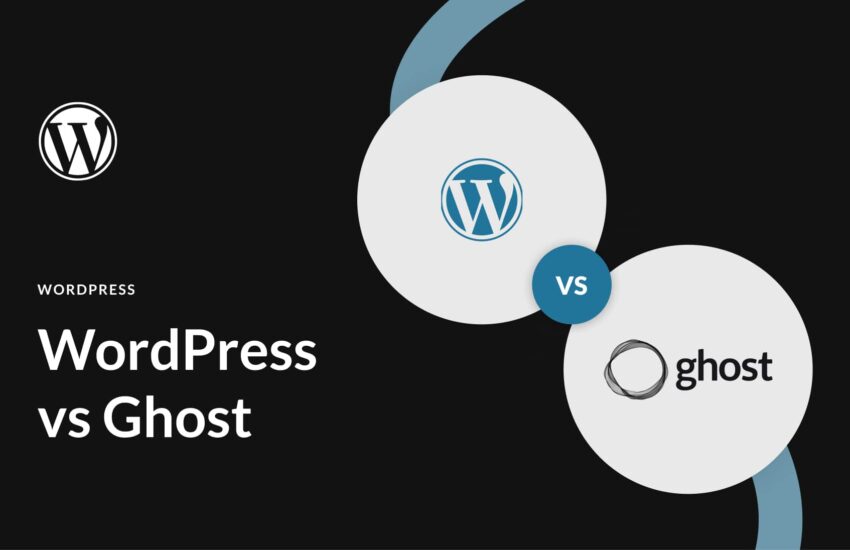15 Free Webhosting Tools And Services You should know before You host a Website Or Blog to Save Time and a lot of Money
Hi, welcome to The SmartGoat Blog. In this post I am going to write about 15 free Webhosting related tools and services you should know as a website or blog owner. I use them daily, and highly recommend them. It consists of three parts, 1. website setup, 2. Content Management and Monetization, 3. Security and Monitoring and Metrics. Let’s jump right in

Website Setup, step 1 of Webhosting
Let’s begin with website building.
1. Domain Name:
Webhosting begins with a domain name. You need a domain name to stand out, and a subdomain from some hosting provider doesn’t look good. It is one of the first things you are going to spend your money on, and it is going to be a recurring payment. When purchasing a domain name, prioritize the ‘renewal price’ over the initial cost. And don’t bother paying extra for privacy, SSL, etc, they come free with most services. My picks for domain name registrars are Cloudflare and Porkbun.
Cloudflare has a little price advantage, but Porkbun offers more flexibility and more variety, both of them offer the cheapest yet one of the best services you could ask for. I liked the Google domain, but it is gone now, I don’t recommend buying a domain name from GoDaddy, or CMS providers like Wix or Squarespace, you end up paying more.
Also, go with “.com” if it is available, or go with something short and memorable.

2. DNS Service (with added benefits):
Your domain registrars do provide DNS service too, but I always highly recommend Cloudflare for this.
You not only gain access to one of the largest DNS and CDN providers in the world (20% of the global internet goes through them) but also one of the best Website security solutions for FREE. Cloudflare does a good job with its free tier services speeding up as well as protecting websites. All of my websites go through Cloudflare, and it has been a fantastic experience. There is a bit of a learning curve.
3. CMS (Content Management Software)
CMS is the piece of software that powers your websites, so it is a big part of your web hosting journey, so you have to choose wisely. You probably know WordPress, which is a CMS. For a beginner To build a website WordPress can be a great option, and for a good reason it powers 40% of all websites, including some massive ones. WordPress can build anything and everything, so it is fairly complex, and takes time to learn.
But you should know about some other CMSs too, especially Ghost for beginners. If you are planning for a blog, I think you should choose Ghost for it, it is open source too, and much much easier to manage a blog with an email newsletter, and subscription built-in. It is more refined for blogs, this site uses Ghost. Here is a post about how to host a ghost blog for FREE.

For a user-friendly, drag-and-drop website builder, options like Wix, Squarespace, and Webflow are available. However, they tend to be pricier. I personally use Wix for my business website, and I am happy about it. You can design really beautiful, websites using Webflow, but it has its own learning curve. Squarespace too is a popular option and probably the easiest among these three.
4. Hosting (Free vs Paid)
After selecting your domain name, DNS service, and your CMS of choice you need a hosting provider, basically a Computer to serve your website. You need a web server, preferably a virtual machine hosted in the cloud for your website, or you can use a computer at your home (not recommended). Hosting comes in different flavors. Managed hosting, VPS (server), and unmanaged. I am not going in too deep. But for managed hosting, you have to pay, and the cost varies depending on quality and quantity. Hostinger is a beginner-friendly choice for affordable and reliable WordPress hosting. Ghost provides its own hosting service at Ghost PRO. Here is a detailed post about different Ghost hostings. Unless you are ready to take a lot of headaches off of self-hosting a production website, you probably should go with managed web hosting.
You can also rent a virtual private server and set up your own hosting. This is cheaper and gives more control, but needs more work. But you can get a good hosting option for FREE too. Although the free options are not extensive, here is a Comprehensive List Of Free and Cheap VPS. Oracle and Google have good free-tier options.
In the early days of your blog, you can start with free hosting, but when your blog is sustainable, or In the case of a business website, you should go for a paid option, because it offers peace of mind and easy manageability. (get a 30% discount on Hostinger).
5. CDN:
CDN or content delivery networks distribute your site content across multiple data centers across the globe helping your website load faster. I have used three CDN providers myself and liked all three. Highlighted are their key features.
- Cloudflare: Free, Unlimited Bandwidth, Easiest to set up.
- Cloudfront: 1 TB/per month free relatively hard, better performance than Cloudflare in my testing.
- Bunny: Minimum 1 dollar/month. Good service with Nice support. Their high bandwidth video CDN is very cheap. Get Bunny here. Currently, I have switched to Bunny myself.
My go-to CDN is Cloudflare, I have started using CloudFront too, but it is not for beginners. Here is how I optimize my ghost blog with Cloudflare CDN.

Our web server is located in Amsterdam, but traffic is Global (look at the blue areas on the map,)
6. Image Delivery Solution:
It may sound unnecessary, but believe me, it will make your life a lot easier in the long run. For any website, Particularly for blogs and websites with numerous images, I recommend establishing a separate image solution from your main web server. It reduces hosting space requirements, loads on the web server, and your site faster.
I use Cloudflare R2 along with Gumlet Image CDN (referral link) Optimizer. Cloudflare R2 is a cheaper alternative to S3. I store all my images in Cloudflare R2 (Image Source in the below illustration). They offer 10 GB of storage for free, and bandwidth unlimited. Then add Gumlet on top of that. Gumlet is an image delivery CDN, they pull the images from your R2 bucket compress, crop, and optimize them for the best experience for your users, and then deliver the images from their CDN. They offer 30 GB of bandwidth for free per month, which is a lot. Insert your images in your website content from the Gumlet URL. This approach facilitates smoother operations for tasks such as backup, maintenance, site migration, and upgrades. Other than R2 there is Backblaze B2 (cheaper in the long run).
Content Management and Monetization, step 2 of Webhosting
Now that you have successfully set up your website let me talk about things you need to know in the content department.
1. Email Delivery
Email delivery is a crucial part of authentication, newsletters, etc, and my go-to choice is Brevo, their free tier is the best out in the market with 300 emails/ day for free. I use it and the delivery rate is good. I also use Mailgun for ghost and they offer 1000 emails/ month for free.
2. Image Sourcing
The next big part of a website is image sourcing. And here is what I use myself and you will also find helpful.
- Whenever possible, use your own pictures.
- Unsplash – Huge library for free to use images
- Bing Image Creator tool: Yes use DALL-E 3 from OpenAi for free in Bing image generator and make AI generate images for you.
- Microsoft Designer: Yup I use it, I found it easy to use and its free AI features do come in handy. All the images in this blog are edited by Microsoft Designer.
3. Content Writing
Webhosting is the easy part of website building, content is harder. And you should write your own content. But that does not mean you should not use them. You should use them to expand your idea, or optimization of your writing, and formatting. ChatGPT yet does not have a competitor in this field. And you don’t need to pay for GPT 4, GPT 3.5 for free is more than enough.
But it is a changing landscape, so I am probably going to be wrong about this AI part.

Another game-changing product for me was Grammarly. I use the browser extension. Helps a lot in my writing.
4. Search Appearance
Now I believe you also want your website to appear in search results. To do that you need to submit your website to Google Search Console and Bing Webmaster Tool. Have a proper robots.txt file and sitemap. You can get those using WordPress plugins. Or most solutions auto-genarate them. You just need to submit the sitemap to Google and Bing (yes don’t ignore Bing).

5. Site Scanner tools (SEO)
SEO has become a part of web hosting now. And you should focus a little on SEO, after all, you need to rank. The most important first piece for a good ranking is good and helpful content. After that look for SEO tools. I would suggest you use the free plan of two solutions, Ahrefs and Semrush. I use them(free version) mostly to find out problems in websites especially links, redirects, etc related. You will also gain a deep insight into your website. Also get a good SEO tool, like RankMath, Yoast SEO, or AIOSEO for WordPress. Ghost, Wix, etc come with basic SEO built-in.
6. Social Networking
You should take social networking more seriously, especially to route traffic from social networks to your website. A good social strategy actually adds healthy referral traffic. I advise you to open a social account for your website on all social media, whether you love it or hate it, and share your links there. Some good places are Twitter, Reddit, and Quora. Try to build an engaging social media audience who will become your regular source of traffic. Also, add a social share widget in your pages or posts to make it easy to share. It definitely helps.
7. Monetisation:
Webhosting costs money and time, so your site should bring money, happiness or both to you. Monetisation generally has three sources Ad revenue, Affiliate Links, and Subscription. Oh and if you have some product to sell(physical/virtual) then that is great too.
- Ad Revenue: After you have 10 decent posts on your site apply to the Google AdSense Monetisation programme. Another good option for a small website is Ezoic, but they are more selective. Start with AdSense and later switch to Ezoic. But this source is drying up each day due to the rise in adblockers. And tech-related sites are more affected by the adblockers.
- Affiliate links: They are lucrative and pay more, but harder to pull off. Amazon associate is a good source of affiliate income.
- Subscription and Donations: This is the hardest form of monetization, but if you cracked the code, this is the most rewarding.

Security, Monitoring, and Analytics, step 3 of Webhosting- An important one.
Finally, let’s talk about a crucial but often forgotten thing, It is security Monitoring and Analytics
1. Analytics:
In the department of Web Analytics you should know 4 names
- Google Analytics: Most popular analytics, a ton of data
- Cloudflare Insights: Good source for Real User Metrics
- Microsoft Clarity: Get a screen recording of how your visitors are using your website
- Umami / Plausible: A self-hosted basic analytics tool, usually adblockers don’t block them as it offers strict privacy, so you get a better understanding of your actual number of visitors ( sadly over 60% of my visitors use adblockers, we came to know this from Umami’s statistics).
I don’t want your personal data, I just want to make sure my website is optimal for end users.
2. Monitoring
Use Uptimerobot for monitoring your website and services. If you are comfortable with self-hosting then Uptime Kuma is a fantastic option. I use two uptime Kumas hosted for free in two different cloud providers and in two different regions to monitor all my online properties. If any of my websites, webservers, or any other services go down within 20 seconds I get emails, telegram messages, and discord messages about that outage.
3. Security
Finally, let’s talk about security. Always use a password manager and two-factor authentication wherever applicable. Getting hacked is the worst thing to happen.
If you are self-hosting in a VPS disable all the unnecessary ports, I also prefer to close the public SSH port and use Tailscale to SSH into the server.
And, if you are a self-hosting pro, host your own VPN server for free and restrict sensitive operations to the static IP you received with the VPN. It really adds an extra layer of security.
Conclusion
In conclusion, establishing and maintaining a website or blog involves a multifaceted approach, from strategic domain choices to content management and monetization strategies, and finally, robust security measures. Embracing free and efficient services can significantly optimize your efforts, saving both time and resources. Remember, continual learning and adaptation are key in the dynamic online landscape. Best of luck with your website endeavors, and feel free to reach out for more insights or assistance along the way. Happy creating.







